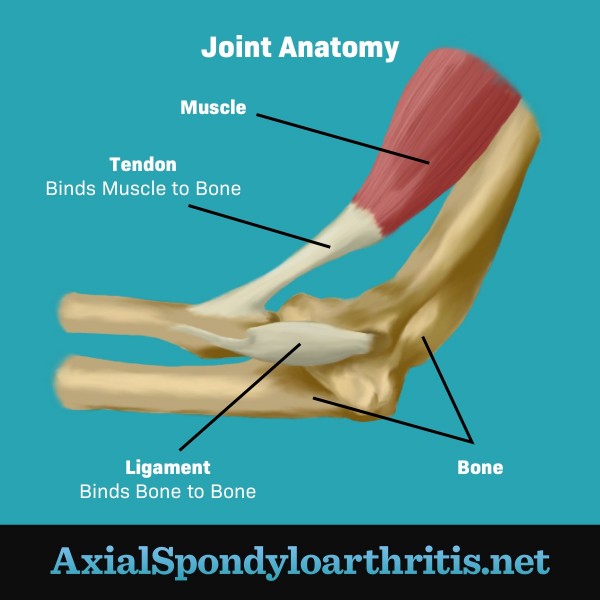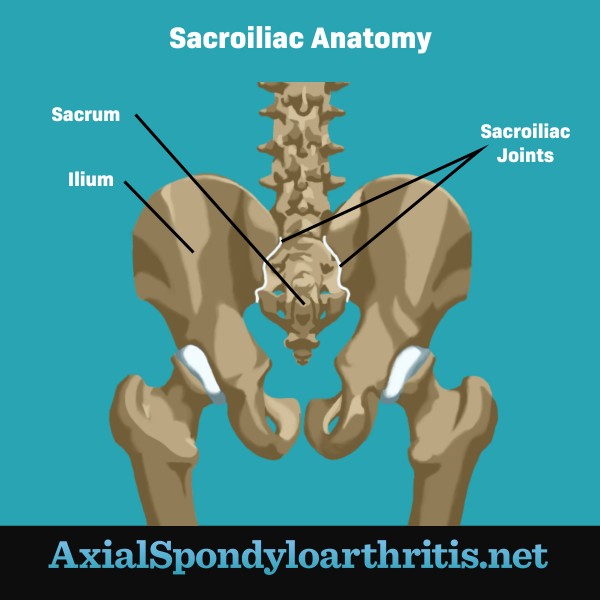What Parts of the Body Does Axial Spondyloarthritis Affect?
Reviewed by: HU Medical Review Board | Last reviewed: September 2022 | Last updated: April 2023
Spondyloarthritis is a form of arthritis that affects the joints and the sites where ligaments or tendons connect to bone. Axial spondyloarthritis (axSpA) mainly affects the spine but can also affect other joints.1
AxSpA is called radiographic axial spondylitis if damage and inflammation are seen on X-rays. This is more commonly known as ankylosing spondylitis (AS). When a person has pain and symptoms but no damage is seen on X-rays, the condition is called non-radiographic axial spondyloarthritis (nr-axSpA).1
Knowing more about your anatomy can help you understand just how AxSpA can affect the body and why certain symptoms may occur.1
Parts of the spine
Your spine is made up of 33 bones called vertebrae. These bones sit one on top of the other. In between each vertebra are rubbery discs that act as shock absorbers. The spine protects your spinal cord, which carries messages between your brain and the rest of your body.2
The bones of your spine are divided into 5 sections. Each section has a different number of vertebrae, varying in size and shape to provide different levels of support and flexibility. Together, these bones allow a person to stand upright, bend, twist, and move their head from side to side.2
Figure 1. Parts of a basic human joint
The sections of the spine are:2
- Cervical spine (neck) – The top 7 vertebrae are called C1 through C7. They start at the base of your skull and make up the neck.
- Thoracic spine (middle back) – The 12 vertebrae in the mid-spine are called T1 through T12. This is where your ribs attach to your spine.
- Lumbar spine (lower back) – Known as L1 through L5, these 5 vertebrae make up your lower back.
- Sacrum – This triangular-shaped bone is found below the lumbar spine. It is made up of 5 vertebrae that are fused together, called S1 through S5. The sacrum connects to your hips on either side at the SI (sacroiliac) joints.
- Coccyx – This is a small bone made up of fused vertebrae at the bottom tip of your spine. The coccyx is where the ligaments and muscles of the pelvis attach to the spine. It is commonly called the tailbone.
Figure 2. The lumbar spine, pelvis, sacrum, and ilium
Spine and joint symptoms
The first symptom of axSpA is usually pain in the low back, buttocks, or hip. Sometimes, more commonly for women, pain is first felt in the neck. Some children may have pain in their hips, knees, or heels before they have pain in their back.1,3
The SI joints are often affected. These joints connect your pelvis and lower spine. When the SI joints are inflamed and damaged, pelvic, hip or lower back pain can result.1
AS can progress from the SI joints to the joints between the vertebrae, causing more back pain.1
Enthesitis
Enthesitis is inflammation of the entheses. The entheses are the points where tendons or ligaments attach to bone. Enthesitis can cause pain and stiffness in the affected joints. In axSpA, including AS, the heel and the bottom of the foot are common sites of enthesitis.4
Bony fusion
As the condition worsens, the spine becomes less mobile. This is because the bones grow and fuse, forming a structure that looks like bamboo on an X-ray. This is known as "bamboo spine." Having bamboo spine increases your risk of having fractures in your spine.5
As the bones of the spine fuse, pain and stiffness decrease the flexibility in the spine. This can lead to a loss of the normal spine curvature. Fusion of the joints between the ribs and spine or between the ribs and the breastbone can make it difficult to expand the chest fully. This can cause chest pain or difficulty taking deep breaths.1
Hip and shoulder symptoms
People with axSpA can have hip or shoulder pain. When the disease affects the hips, it may cause referred pain. This means that a person may feel the pain in their groin, the front of their thigh, or in their knees.1,6
Eye symptoms
Many people with AS and nr-axSpA have inflammation in the eyes, called uveitis or iritis. This can cause eye pain and sensitivity to light (photophobia).6
Wrist, finger, and toe symptoms
Sausage-shaped swelling can affect 1 or more fingers or toes. This is known as "sausage digits," or dactylitis.6
Foot and heel symptoms
Achilles tendon pain and swelling are common. Some people with axSpA have pain in their heels and feet. Pain can occur in any part of the foot, but it is most common in the heel and bottom of the foot.6
GI, heart, and lung symptoms
Inflammation from axSpA can cause other symptoms in the gut, heart, and lungs. These may include:1
- Belly pain and diarrhea
- Increased risk for heart attack and stroke
- Rare inflammation of the aorta, the largest artery that leads to the heart
- Rare lung complications
AxSpA affects many parts of the body. It is important to see a doctor if you think you may have this condition so that you can get proper treatment. Early diagnosis and treatment can help prevent further damage to the joints and other parts of the body.1

